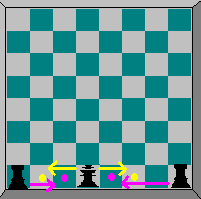| Contents:
Rooks |  |
 E-mail E-mail |
This move was invented in the 1500's to help speed up the game and to help balance the offense and defense. The castling move has some fairly rigid caveats:
The king moves two squares toward the rook he intends to castle with (this may be either rook). The rook then moves to the square through which the king passed. Hopefully, the diagram to the left makes this clear. Strategy Note: Castling is a great aid in defensive strategy. It also has a tendency to bring a powerful rook into play when under normal circumstances it might be stuck behind a wall of pawns.
 Go To Next Page Go To Next Page
|
|
